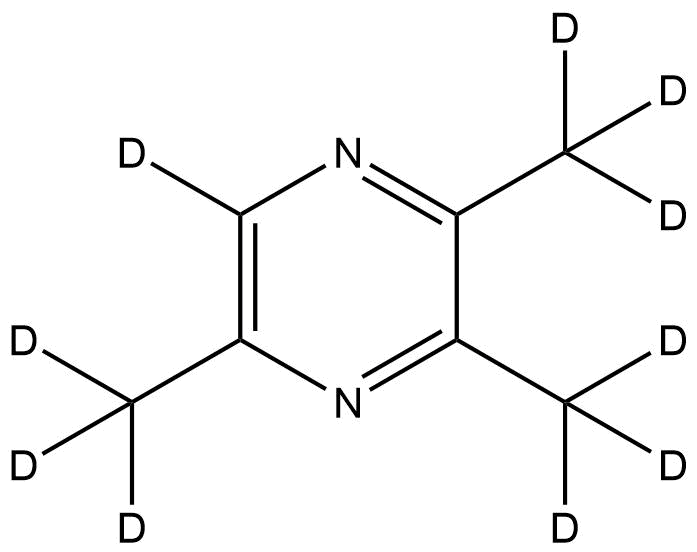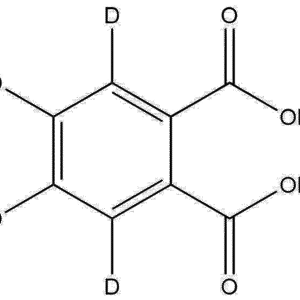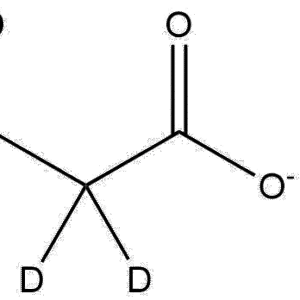OVERVIEW
2,3,5-Trimethylpyrazine-d₁₀ is a fully deuterated isotopologue of 2,3,5-trimethylpyrazine, a heterocyclic aromatic compound known for its distinctive roasted and nutty odor, commonly found in Maillard reaction products. In this deuterated analogue, all hydrogen atoms in the methyl groups and the pyrazine ring are replaced by deuterium atoms, resulting in a +10 Da mass shift. This substitution preserves the chemical and physical properties of the parent compound while making it particularly useful for analytical and spectroscopic applications that require isotopic labeling.
The compound is frequently employed as a stable isotope-labeled standard in analytical chemistry, especially in gas chromatography–mass spectrometry (GC-MS) and nuclear magnetic resonance (NMR) spectroscopy. Due to its stability and isotopic enrichment, 2,3,5-Trimethylpyrazine-d₁₀ serves as an essential tool in flavor chemistry, environmental monitoring, and metabolic pathway studies involving pyrazine derivatives.
CHEMICAL INFORMATION
-
Name: 2,3,5-Trimethylpyrazine-d₁₀
-
Molecular Formula: C₇D₁₀N₂
-
Molecular Weight: 132.23 g/mol
-
CAS Number: 14667-55-1
-
Isotopic Enrichment: ≥ 98 atom % D
-
Chemical Class: Deuterated pyrazine; heteroaromatic compound
-
Functional Groups: Aromatic nitrogen heterocycle, methyl substituents
-
Stability: Stable under normal laboratory conditions
APPLICATIONS of 2,3,5-Trimethylpyrazine-d10 | CAS 14667-55-1
-
Mass Spectrometry (MS) Internal Standard:
2,3,5-Trimethylpyrazine-d₁₀ is widely used as an isotopically labeled internal standard in GC-MS and LC-MS analyses of volatile organic compounds (VOCs). The +10 Da isotopic shift allows for precise quantification of native 2,3,5-trimethylpyrazine in complex matrices such as food, environmental samples, and fermentation products. -
Flavor Chemistry and Food Analysis:
The compound is instrumental in flavor profile studies and aroma quantification. It helps track and quantify the presence and formation of pyrazine derivatives that contribute to roasted, chocolate, and nutty flavors in thermally processed foods such as coffee, cocoa, baked goods, and roasted meats. -
NMR Spectroscopy:
The extensive deuterium substitution significantly reduces proton background noise, enhancing spectral resolution. This makes it valuable for NMR calibration, solvent suppression studies, and deuterium exchange experiments involving heteroaromatic systems. -
Metabolic and Kinetic Studies:
Used as a tracer molecule in biochemical studies investigating the formation and degradation of pyrazine compounds. The isotopic label enables precise determination of reaction kinetics and mechanistic pathways. -
Environmental and Industrial Monitoring:
Applied in environmental analyses to monitor and quantify pyrazine derivatives arising from combustion, fermentation, or industrial emissions. Its isotopic signature allows for clear distinction between background and analyte signals.
ADVANTAGES of 2,3,5-Trimethylpyrazine-d10 | CAS 14667-55-1
-
Fully deuterated (10 D atoms) structure provides clear isotopic differentiation.
-
Excellent chemical stability and minimal isotope exchange under standard conditions.
-
Ideal internal standard for volatile organic compound (VOC) quantification in complex matrices.
-
Maintains identical physicochemical behavior to the non-deuterated compound.
-
Enhances precision and reliability in both GC-MS and LC-MS analyses.
-
Non-radioactive and environmentally stable isotopic label.
HANDLING
2,3,5-Trimethylpyrazine-d₁₀ should be handled using standard laboratory precautions:
-
Avoid inhalation of vapors and direct contact with skin or eyes.
-
Use in a well-ventilated area or fume hood.
-
Wear protective gloves, safety goggles, and lab coats.
-
Store in tightly sealed containers at room temperature, away from heat and oxidizing materials.
-
In case of contact, rinse thoroughly with water and seek medical attention if irritation persists.
While the compound has low acute toxicity, it should not be ingested or inhaled in concentrated form due to its potential irritant nature.
QUALITY & SPECIFICATION
Each batch of 2,3,5-Trimethylpyrazine-d₁₀ is rigorously analyzed to confirm isotopic purity, chemical identity, and structural integrity. Typical analytical verification includes:
-
¹H / ²H NMR Spectroscopy: Verification of deuterium incorporation and distribution.
-
Mass Spectrometry (HRMS): Confirmation of isotopic enrichment and molecular mass shift.
-
Infrared (IR) Spectroscopy: Identification of characteristic functional groups.
-
Purity: ≥ 98 %
-
Isotopic Enrichment: ≥ 98 atom % D
A Certificate of Analysis (COA) is provided with each batch, detailing purity, isotopic composition, and analytical results for quality assurance.
SUMMARY
2,3,5-Trimethylpyrazine-d₁₀ (CAS 14667-55-1) is a high-purity, fully deuterated aromatic compound designed for advanced analytical and research applications. Retaining the characteristic chemical behavior and aroma of its non-deuterated form, it is an indispensable standard in GC-MS, LC-MS, and NMR spectroscopy. Its precision isotopic labeling makes it an ideal reference for quantitative flavor analysis, metabolic tracking, and environmental monitoring. As a stable, non-radioactive isotope compound, 2,3,5-Trimethylpyrazine-d₁₀ represents a cornerstone reagent in analytical chemistry and food science research.
Learn more about,
Deuterated Polymers: A Cornerstone Guide to Synthesis, Applications, and Future Trends
Availability of All the Deuterated Chemicals at ResolveMass Laboratories Inc.
ResolveMass Laboratories: Leading Deuterated Chemical Synthesis Company in the United States.
Deuterated Internal Standards for LC-MS: Selection & Custom Synthesis
How to Choose the Right Deuterated Labelled Chemical Synthesis Company in Canada
How to Choose the Right Deuterium Labelled Compounds Supplier for Your Lab
Deuterium-Labelled Compounds — Synthesis, Applications & Ordering





Reviews
There are no reviews yet.